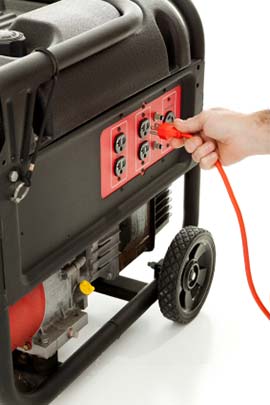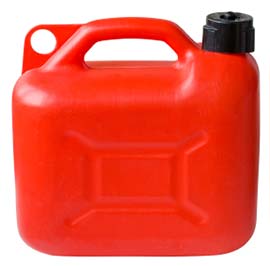Generator Safety
Standby or Emergency Generators

Reliable electricity is a service we all expect and take for granted, until we lose power due to an outage. Typically, power outages are restored within a few hours, but during major ice storms, wind storms, or other disasters, it could take several days or longer for power company crews to restore power to everyone.
Inexpensive emergency back-up generators are available from home centers, mail order, and internet sources, so many of us keep a generator around for use when the power goes out. Backup generators are handy, but they can also create a dangerous situation if not connected properly to your home’s electrical wiring.
Generators are sometimes permanently attached to the home wiring. If the connection to the home wiring is not done correctly, then the generator can feed into BARC’s power system and can electrocute linemen who are working to restore power.
Generators should never be connected to a home electrical outlet and should not be directly connected to the circuit breaker panel. Generators should only be connected to the home through what is called a “double pole, double throw switch”, sometimes called a two-way transfer switch. A qualified electrician can properly do this work. BARC’s responsibility for electric service ends at the meter, so we cannot know when or if you have installed a generator and we cannot know if the installation was done in accordance with the National Electric Code. Refer your electrician to the National Electric Code 700.6 and 702.6.
Another reason for using a qualified electrician to do the work. If you plug your generator directly into a wall outlet, then the wiring in your house is no longer protected by a circuit breaker or fuse in your power panel. The wiring could become overloaded, overheat, and start a fire in your house.
Finally, the diesel or gasoline engine that drives an emergency generator has carbon monoxide in the exhaust. Carbon monoxide is a colorless, odorless gas that can be deadly. Always consult the owner’s manual or operator’s manual for your generator regarding proper placement of the generator.
BARC personnel are ready and willing to advise you regarding the installation of an emergency electric generator. You can call us at 800-846-2272 and we will be happy to speak with you.
The following information provides additional understanding of emergency or backup generators and may help you determine the right solution for your home or business.
Fixed or Stationary Generators
Large, fixed generators are usually directly connected to building wiring to provide standby power during emergencies and power outages. However, the wiring needs to be properly installed by a qualified electrical contractor. Properly installing a “permanent” generator is extremely dangerous, and not a “do it yourself” job. If you plan to have this type of generator installed, you may need to obtain an electrical permit from your local electrical or building inspector’s office. Typical installations are described and pictured below.
Portable Generators
Small portable generators are available from most home supply stores. The capacity of this class of generator is usually too small to power the entire household but is adequate to handle some combination of necessary loads such as a well pump, outdoor wood stove fans and circulators, a refrigerator or freezer, etc. As mentioned above, generators should NEVER be plugged into an outlet to “back feed” your house. Doing so will create the likelihood that your home wiring will become overloaded and overheat, representing a significant risk of fire. You may also energize the “dead” power lines outside of your house, creating a life-threatening safety risk for linemen who are not expecting the lines to be “hot”.
“Back Feeding” – a dangerous condition
Improperly connecting a portable generator to electric wiring can produce “back feed”- a dangerous current that can electrocute or critically injure you or others. Back feed into power lines from a generator could create “hot” power lines during an outage. Linemen who expect the line to be de-energized could be injured. One good way to avoid back feeding is to install a double-pole, double-throw transfer-switch gear. A qualified electrical contractor can install this transfer switch so that a dangerous back feed can be prevented.
In accordance with the National Electric Code, paragraph 700-6; “Transfer equipment shall be designed and installed to prevent the inadvertent interconnection of normal and emergency sources of supply in any operation of the transfer equipment. Automatic transfer switches shall be electrically operated and mechanically held.” The transfer switch must be a break-before-make switch which will “break” the electrical connection with commercial power lines before it “makes” the connection between your generator and wiring. The switch also will prevent utility power from damaging the generator when regular service is restored. Make sure the transfer switch is rated at the same or greater than the main overcurrent protection.”
An electrical diagram of a typical installation using a transfer switch appears in See Figure 1. You should always consult a licensed and experienced electrician and follow all local building and electrical codes.
Since transfer switches can be expensive, another way to install a generator is to have a sub-panel with main breakers and power from the main power or generator. The main panel breaker and generator breaker in the sub-panel would have handles interlocked to prevent both from being opened and close at the same time. This prevents back feed to commercial power when the generator is in use. See Figure 2.
Another option for a portable generator connection would be a GenerLink. These units are installed by BARC. GenerLink information.
1. Install breaker and wiring from main panel to feed sub-panel. Note: Wiring and breaker sizes are determined by circuit load needed.
| Amp | Wire Size |
|---|---|
| 20 Amp | 12-3 with ground wiring |
| 30 Amp | 10-3 with ground wiring |
| 40 Amp | 8-3 with ground wiring |
| 50 Amp | 6-3 with ground wiring |
2. Install sub-panel with proper sized main breakers.
Power for one from the main panel and the other from the generator.
3. Install dual supply main breaker / service disconnect retaining kit and handle interlock. Note: Not all manufactures supply the handle interlock retaining kits for all models of breaker disconnects.
4. Install breakers in sub-panel for circuits desired to be energized from generator. Note: Smaller generators may not be able to carry the total load for all circuits. Use the load calculation chart (Figure 3) to determine total load. A smaller generator than the total load can be used by turning off some of the breakers when the appliance or lights are not needed. Always use a generator that is at least 25% larger than most necessary loads. This allows for some of the nonessential loads to be used at once.
The dangers of carbon monoxide
When using a generator, be sure to locate it outside so that poisonous carbon monoxide gas is exhausted. Never operate a generator in an enclosed building, especially in a building attached to a dwelling. Make certain, too, that the generator has enough air to breath and that its exhaust is vented properly. Fumes from burnt fuel can be deadly. Always insure proper ventilation, and air flow around the generator.
Generators and water don’t mix
Do not use a portable generator in a flooded basement. It is a potentially dangerous combination. In addition, make sure your hands are dry, that you’re standing in a dry place, and the generator is properly grounded whenever you operate it.
Using gasoline safely

Gasoline should only be stored in approved containers, and out of reach of children. It goes without saying that all flames or cigarettes should be extinguished when handling gasoline. Have a fully charged, approved extinguisher located near the generator, and never fuel a generator while it is running.
Here are some rules to follow to help assure that generators are installed and used safely:
- Always check out the unit thoroughly each new season before you fire it up.
- Never attempt to repair an electric generator, only a qualified serviceman should perform repairs.
- Don’t remove or tamper with safety devices; they are there to protect you and your property.
- Many engine parts are very hot during operation, severe burns may result if touched.
- Keep children away from generators at all times.
- Always properly disconnect from your utility service before starting your backup generator.
Don’t put your life at risk
Electric generators can provide you with peace of mind and convenience as long as you don’t take chances with your safety or the safety of others. Be sure to follow these safety guidelines so you don’t put yourself or the lives of others in danger. Improper use or installation of an electric generator can cause property damage, serious injury, and even
death.
You should always consult a licensed and experienced electrician and follow all local building and electrical codes.
